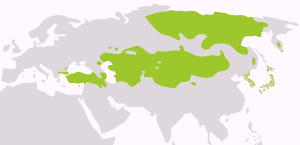Altaic languages facts for kids
Quick facts for kids Altaic |
|
|---|---|
| (discredited) | |
| Geographic distribution: |
East, North, Central, and West Asia and Eastern Europe |
| Linguistic classification: | Proposed major language family |
| Subdivisions: |
Koreanic (sometimes included)
Japonic (sometimes included)
Ainu (sometimes included)
|
| ISO 639-2 and 639-5: | tut |
 Distribution of the Altaic languages across Eurasia.
|
|
Altaic is a disputed language family, but only a few linguists still believe that it existed. It supposedly had 66 languages that are now spoken by about 348 million people, mostly in and around Central Asia and northeast Asia.
According to the most well-known classification, Altaic has the Turkic languages, Mongolic, and the Tungusic languages. That is probably the meaning attributed to "Altaic" by most general linguists.
However, since the publication of Gustaf John Ramstedt's Einführung in 1952–1957, most Altaicists have included Korean in Altaic. Since the publication of Roy Andrew Miller's Japanese and the Other Altaic Languages in 1971, some also included Japanese (Nicholas Poppe) or Japonic, consisting of Japanese and Ryukyuan.
A few linguists (such as (Street 1962)) even count Ainu with the Altaic languages but as part of a node including Korean and Japanese, in contrast to a Turkic-Mongolic-Tungusic node, with Korean-Japanese-Ainu and Turkic-Mongolic-Tungusic, in turn, forming a higher-level node.
The core version of Altaic, consisting of Turkic, Mongolic, and Tungusic, is sometimes referred to as "Micro-Altaic," and the expanded version, including Korean and sometimes Japanese, is referred to as "Macro-Altaic," but even the core version is very controversial.
Images for kids
-
The Altai Mountains in East-Central Asia give their name to the proposed language family.
See also
 In Spanish: Lenguas altaicas para niños
In Spanish: Lenguas altaicas para niños


